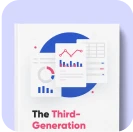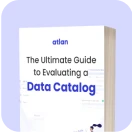Comprehensive Guide to Data Governance and Risk Management: Definition, Strategies, and Tools
Share this article
How does data governance help in managing data risks? #
Managing data risks effectively is crucial, especially considering that the average cost of a data breach is $4.88 million, according to IBM. Data governance plays a vital role in mitigating these risks by ensuring data security, compliance, and quality.
Here’s how data governance helps manage risk:
- Reduces data breaches and leaks
- Ensures regulatory compliance
- Enhances data accuracy and integrity
- Minimizes financial losses and reputational damage
See How Atlan Simplifies Data Governance – Start Product Tour
Poor data governance can expose your organization to several risks, including data breaches, compliance violations, and operational inefficiencies. Without proper governance, you risk inaccurate data, regulatory fines, and potential reputational damage.
In this article, we’ll explore these risks, explain how data governance addresses them, and demonstrate how Atlan’s solutions can help secure and manage your data effectively.
Table of Contents #
- How does data governance help in managing data risks?
- How does data governance contribute to effective risk management?
- Why is data governance important for managing risk?
- How do you govern data to manage risk effectively?
- How does Atlan’s data governance solution help in managing risk?
- How companies mitigate risks using Atlan
- Conclusion
- FAQs about data governance and risk management
- Data Governance and Risk Management: Related reads
How does data governance contribute to effective risk management? #
The four major data breach risk categories are privacy, security, compliance, and business value. Data governance offers risk management for each of them:
- Privacy risks: Private information being leaked or stolen from your data system.
For example, if you’re storing personally identifiable information (PII) like users’ emails and phone numbers, improper processes around how you handle that data are a major risk for users having their identities stolen. Breaches like this can result in direct financial damages, hefty fines, and loss of user trust.
- Security risks: Unauthorized access to sensitive data.
Weak access controls leave multiple angles of attack for malicious actors. A security breach puts your organization at risk, potentially resulting in shutdowns, ransomware attacks, legal consequences, and more.
- Compliance risks: Violating a regulation or standard.
Without clear governance standards, it is difficult to keep all your data assets in line with regulatory requirements. Compliance violations can result in hefty fines and legal penalties. This is especially important in an era of developing regulations around AI systems.
- Business value risks: Failing to capture the full business value of your data assets.
Your data is a major competitive asset. But if you have poor data quality and poor governance integration, you risk wasted development time and isolated knowledge siloes across your organization. Good governance solves both of these risks by ensuring that high-quality data is available and accessible for collaboration across your entire organization.
Why is data governance important for managing risk? #
Data governance describes the collective systems that your organization uses to specify decision rights and accountability for your data assets and information.
Functionally, data governance boils down to the policies and software tools that manage data — chief of which is your data catalog platform.
Your data catalog serves as a single pane of glass for overseeing and orchestrating the different faces of data governance tasks, like role-based access controls (RBAC), data quality tests, and metadata tags across your entire org. The data catalog helps you establish and then manage:
- Data access policies for minimizing privacy breaches and leaks by making sure that secure information is only available when it is necessary. This aspect of data governance limits any points of entry for attackers, protecting your data system and giving your users peace of mind.
- Data quality tests and metadata tags to help identify and maintain your data assets. Tested, labeled data improves data quality and breaks down data silos — unlocking its value for every team in your organization and leaving nothing on the table.
- Data policies and data glossaries to establish your organization’s truth and language. This aspect of data governance facilitates compliance with any regulatory requirements by making your governance policies accessible and clear, keeping your systems in line with standards and protecting you from fines.
How do you govern data to manage risk effectively? #
Data governance helps you mitigate the risks of your data system via four key data management vectors:
- Integrated data governance
- Modern data catalog
- Data quality metrics
- Data products
Let’s look at each one of these in detail.
Integrated data governance #
Setting policies around risk management is important. Unless these policies are integrated into — and supported by — the tools and processes your teams use every day, though, most people will simply ignore them.
Effective data governance is a structural part of everyone’s daily workflows. Integrating your data governance tools and policies directly into your stack keeps your data secure and compliant at all points in your system. But this alone is not enough to eliminate risk: True data security requires building a culture of responsibility and accountability around your data assets, with each and every data user cutting off any potential access points for security breaches.
What does integrated data governance look like in action? It includes:
- Using integrated tooling, so users don’t need to visit a separate website to perform common data governance tasks such as tagging data or managing access permissions.
- Adopting embedded collaboration tools that enable users to quickly communicate with one another and resolve questions about data.
- Allowing users to find data from inside the business intelligence tools they use every day, like Looker or Power BI.
Modern data catalog #
You can’t manage data if you can’t find it. The biggest data-related risk for your business may actually be a data silo whose contents aren’t subjected to the rigorous governance policies you’ve put in place to govern, secure, and improve the quality of data.
- A modern data catalog solves this hidden data problem with automated metadata and data lineage generation to allow for data security and discoverability at scale.
- It also activates your data’s value through embedded collaboration tools for data sharing and discussion, breaking data silos and improving data accessibility.
Data quality metrics #
Poor data quality is a huge risk to your business. Malformed data can break data pipelines or reports, robbing people of the information they need to make time-sensitive decisions. Incorrect data can do even more damage, leading teams to make million-dollar mistakes.
- Data quality ensures that a dataset meets agreed-upon standards for dimensions such as accuracy, completeness, consistency, validity, uniqueness, and timeliness.
- Good data quality tools enable tracking data quality metrics at the group and organization level so you can monitor, assess, and make improvements to your data over time.
Data products #
Data governance and risk management have long been implemented from the top down. But this heavy-handed approach simply can’t scale to handle today’s mind-boggling data volumes. Traditional governance can stall, or even completely derail, new data-driven initiatives with weeks — or even months — of manual reviews and approvals.
This is why organizations are moving away from top-down centralized data architectures to modern data product architectures — a modern hybrid strategy uniting data governance and risk management.
A data product architecture works as a distributed system when managing an organization’s data estate, which can be anything from a single table to an entire library of data assets. A data product design provides a framework for your teams to curate assets specific to a domain, business unit, region of operation, or brand, along with many other verticals.
- In a data products-based system, individual teams are in charge of managing their own data assets (data storage, data pipelines and transformations, reports, etc) — while centralized tooling makes sure every team properly classifies and secures data according to company policies.
- These curated data products empower your data consumers to discover data assets easily and get the context they need to collaborate more efficiently.
- It enables teams to ship new data products and data product changes quickly without getting bogged down in red tape.
- It gives the organization the tools it needs to monitor compliance (e.g., by verifying the team has properly tagged and secured all sensitive data).
How does Atlan’s data governance solution help in managing risk? #
Atlan is a modern data catalog powered by AI. It provides a single source of truth for your entire data stack with natural language search that provides “a Google for your data.”
- Atlan’s embedded collaboration tools make data governance part of your org’s daily workflows. Integrating governance into your day-to-day operations improves the security of your data handling and increases the value of your data assets by down data silos and identifying uncatalogued data.
- Atlan’s data governance policy and governed business glossary centers ensure that your entire data estate is unified and reliable. This consistency helps you maintain compliance and security across your organization, while automated policy tools allow you to enforce security and compliance at scale.
- Finally, Atlan’s intuitive UI keeps your teams engaged with data governance, protecting your data assets at all points in their development. Engaged teams bolster data quality and usage, delivering on the value of your data.
How companies mitigate risks using Atlan #
As a banking and insurance organization, Porto places a high priority on protecting sensitive information. To avoid penalties for non-compliance and potential lawsuits under Brazil’s LGPD laws, they focus on ensuring data protection and compliance, safeguarding themselves from data breaches and consumer backlash.
Scripps Health needed to protect sensitive healthcare records while expanding its cloud environment. As they grew, they faced a significant challenge—lack of enterprise-scale visibility into their assets, which put them at risk for redundant development and inefficiencies in their systems.
Contentsquare’s team focused on balancing business enablement with building a strong analytics foundation. They understood the importance of data governance in avoiding data reliability risks and complying with protection guidelines, ensuring that poor governance did not become a hurdle to their business growth.
CSE Insurance relies heavily on data to navigate challenging times, estimate exposures, and optimize products. They recognize the importance of reliable, accurate, and validated data to make informed decisions, ensuring the success of their business operations.
Conclusion #
Data governance allows you to mitigate the privacy, security, and legal risks that come with data while building the value of your data assets at the same time. Effectively mitigating risk with data governance requires an integrated governance system and strong automation that supports data product architecture.
Atlan’s modern data catalog provides the automated systems, embedded collaboration tools, and ease of use that you need to manage the risks of your data. See what Atlan can do for your risk management by booking a demo today.
FAQs about data governance and risk management #
How would you define risk management in the context of data? #
Risk management in data involves identifying, assessing, and mitigating risks associated with data privacy, security, and compliance. It ensures that data breaches, regulatory violations, and data integrity issues are minimized, protecting the organization from financial losses and reputational harm.
What is the scope of a data governance program in an organization? #
A data governance program ensures data quality, security, and compliance across the organization. It defines policies for data access, usage, and lifecycle management while ensuring that data is accessible and trustworthy for all stakeholders, reducing risks like breaches and compliance violations.
How can data governance be integrated with existing IT systems? #
Data governance can be integrated with IT systems through modern data catalogs and governance tools, which embed governance policies directly into the daily workflows of users. This integration ensures that governance practices like access control and data quality testing are seamlessly implemented across the organization.
What are the first steps to take when initiating data risk management? #
Start by assessing the organization’s current data risks, identifying sensitive data assets, and establishing clear governance policies for data access, security, and quality. Implement a modern data catalog to manage these policies and engage teams in regular audits to mitigate evolving risks.
Which platforms are most recommended for managing data governance? #
Atlan, recognized as a visionary by Gartner and a leader in the Forrester Wave, offers AI-powered data catalogs that streamline governance, improve collaboration, and provide tools for ensuring data security, compliance, and quality at scale. A platform like Atlan is ideal for mitigating data risks while maximizing data value.
Data Governance and Risk Management: Related reads #
- What is Data Governance? Its Importance & Principles
- Data Governance and Compliance: Act of Checks & Balances
- Data Governance Framework — Guide, Examples, Template
- Data Compliance Management in 2025
- BCBS 239 Compliance: What Banks Need to Know in 2025
- BCBS 239 Data Governance: What Banks Need to Know in 2025
- BCBS 239 Data Lineage: What Banks Need to Know in 2025
- HIPAA Compliance: Key Components, Rules & Standards
- CCPA Compliance: 7 Requirements to Become CCPA Compliant
- CCPA Compliance Checklist: 9 Points to Be Considered
- How to Comply With GDPR? 7 Requirements to Know!
- Benefits of GDPR Compliance: Protect Your Data and Business in 2025
- IDMP Compliance: It’s Key Elements, Requirements & Benefits
- Data Governance for Banking: Core Challenges, Business Benefits, and Essential Capabilities in 2025
- Data Governance Maturity Model: A Roadmap to Optimizing Your Data Initiatives and Driving Business Value
Share this article











